By Shane Cross
The oil and gas industry is hurting right now. Some folks are trying to kick it when it is down. At Trout Unlimited, we understand that many folks in the oil and gas industry are dedicated to the long-term vision of meeting energy needs and passing on a healthy and functioning landscape. While some see conservationists as being at odds with industry, that need not be the case. Some oil and gas companies have been working with groups like TU to develop partnerships which protect and enhance fish and wildlife habitat in areas near oil and gas development.
For TU, industry partnerships are common sense. Oil and gas will continue to be developed, and it can either be developed in ways that minimize and avoid impacts to trout, or not – our job is to ensure the former. Many of our members depend on the oil and gas industry for their livelihoods, and we recognize that energy development is an important component of the Western economy. TU and industry have worked together to plan development, protect and restore habitat, educate youth, and create responsible oil and gas policies.
Here's a look at some of the good conservation work the oil and gas industry has done with TU over the past few years.
Planning
Berry Petroleum, a subsidiary of Linn Energy, LLC, worked with TU to plan a well pad development near Lake Canyon Lake in the Strawberry River watershed in Utah. Lake Canyon Lake is a brood fishery for Colorado River cutthroat trout, and the local TU chapter had done extensive restoration and habitat work along the lake’s feeder stream.
To develop its pad, Berry needed approvals from Utah’s Division of Wildlife Resources and the U.S. Fish and Wildlife Service. Recognizing the importance of the lake and its fishery to local anglers, Berry Petroleum collaborated with TU before submitting its development proposal.

A happy angler with a Colorado River cutthroat trout caught at Lake Canyon Lake in Utah.
Specifically, Berry analyzed three different access routes to the pad, agreed to utilize a closed loop drilling system and pipeline infrastructure to minimize truck traffic, and maximized the distance between disturbed areas and the waterways. In addition, Berry Petroleum communicated with TU during the construction and reclamation phases – responding to local angler questions during those phases and reseeding a portion of the disturbed area along the lake. The collaborative effort has been beneficial – the Division of Wildlife has met its quota for trout eggs the past two years.
In Colorado, Gunnison Energy, LLC, has been proactive in working with TU and the local community to address concerns about energy development in the Thompson Divide.
The Thompson Divide lies between Mt. Sopris and Grand and Battlement Mesas. In 2013, Senator Michael Bennet introduced legislation, known as the Thompson Divide Withdrawal and Protection Act (TDWPA), that would create a market to buy out existing leases and protect unleased areas from future development. The Senator continues to work with TU and other stakeholders to develop new legislation that will permanently protect the area.

The Thompson Divide in Colorado.
Gunnison Energy holds leases on the south end of the Divide near cutthroat trout streams and popular elk hunting grounds. After numerous meetings with TU and the Thompson Divide Coalition, Gunnison Energy agreed to support new legislation that will protect the Divide with an adjusted boundary that allowed oil and gas development near existing pads. The compromise is an example of industry and conservation interests working together to achieve mutual goals.
Protection
Part of responsible development is the recognition that some places are just too sensitive and are not appropriate for development. In places like Montana’s Rocky Mountain Front, Questar donated leases to be permanently retired with the passage of legislation withdrawing the area from future leasing. Elsewhere in Montana, companies such as ConocoPhillips, Chevron and XTO Energy voluntarily relinquished more than 200,000 acres of leases in the North Fork of the Flathead River Valley, an area that was subsequently withdrawn from leasing with the passage of the widely supported, bipartisan North Fork Watershed Protection Act in 2014.
Restoration
TU’s bread and butter is designing and implementing projects that restore and rehabilitate trout habitat on both public and private land. Recently, Shell Oil worked with TU in Routt County, Colorado, to promote watershed health by supporting two of TU’s projects on local streams. Shell Oil contributed financially to projects to re-grade and plant bank stabilizers on Milk Creek and Armstrong Creek, revitalizing and extending habitat for Colorado River cutthroat trout in the process. In addition, Shell Oil organized a volunteer day with TU for employees to participate by planting willows along Armstrong Creek. Both projects have proven successful and TU is working on additional projects and partners in the watershed.
Education
TU’s Youth Education Program aims to promote awareness and interest in coldwater fisheries by creating opportunities for students to learn about and interact with aquatic systems and species in the classroom. Suncor has been a major contributor to Colorado TU’s Trout in the Classroom program in the Mapleton School District for the past two years. Through the program, students raised fertilized trout eggs into the fry stage and ultimately released them into the South Platte River.

Trout in the Classroom is often the first introduction to conservation for young students.
ConocoPhillips recently funded a similar program in Escalante High School in New Mexico that included coursework on water chemistry, stream ecology and geology to trout biology, trout behavior and the culture of the Rio Chama Valley. Both programs have been successful at engaging youth in watershed health and conservation. And both projects would not have been possible without key financial support provided by our oil and gas partners.
Policy
Against the backdrop of depressed oil and gas prices, it is more important than ever for industry and conservation groups to work together. The Colorado Oil and Gas Association has been working with TU for more than a year to develop pragmatic policy regarding oil and gas development near water resources.
Specifically, as a response to the Front Range Floods of 2013, COGA worked with TU to develop best management practices for oil and gas development in floodplains. Earlier this year, the Colorado Oil and Gas Conservation Commission convened a rulemaking process to address development in floodplains. COGA and TU formed general agreement around many elements of the rule, which requires companies to anchor facilities, install remote “shut in” capabilities on new wells to minimize spills, and install steel ring or other deflectors to reduce under-cutting by floods. TU also recognized that the regulations would come at a cost to industry, and supported a compliance schedule that allowed companies additional time to bring their facilities under the new regulations. We look forward to continuing to work with oil and gas industry associations on policy measures in the future.
Conservation groups and the oil and gas industry – like most of society – will have both conflict and common ground. The conflict, it seems, is talked about more often than the cooperation. We’re here to tell you that dialogue – and collaboration – is occurring between industry and conservation groups and it will continue to occur to ensure that both energy development and fish and wildlife remain strong assets to Colorado’s future.
Shane Cross is Western energy counsel for TU’s Sportsmen’s Conservation Project








 There was no fish mortality documented from the spill, while bug sampling by an aquatic biologist with Mountain Studies Institute indicates a still thriving population of mayfly nymphs and caddis pupa. Colorado Parks and Wildlife (CPW) had installed pens of fingerling trout in the Animas before the plume arrived- and none of those fish died either. CPW ran an electro-shocking episode after the “Spill” with the usual re-capture protocol and got essentially the same results as the year before. Actually, the survey showed a slight improvement.
There was no fish mortality documented from the spill, while bug sampling by an aquatic biologist with Mountain Studies Institute indicates a still thriving population of mayfly nymphs and caddis pupa. Colorado Parks and Wildlife (CPW) had installed pens of fingerling trout in the Animas before the plume arrived- and none of those fish died either. CPW ran an electro-shocking episode after the “Spill” with the usual re-capture protocol and got essentially the same results as the year before. Actually, the survey showed a slight improvement. Getting the river back to it's usual state was no easy task but Trout Unlimited and partners were willing to take the lead. "It’s been quite a year since the Gold King spill sent a torrent of yellow, metal-laden mine water down the Animas River in SW Colorado," said Ty Churchwell, TU San Juan Mountains Coordinator. "But long before this unfortunate event, TU was deeply embedded in the water quality conversation – and now we’ve doubled down. Our efforts to pass Good Samaritan legislation are bearing fruit in the form of a bipartisan discussion draft now working its way through the halls of Congress. We hope to see the bill formally introduced this session."
Getting the river back to it's usual state was no easy task but Trout Unlimited and partners were willing to take the lead. "It’s been quite a year since the Gold King spill sent a torrent of yellow, metal-laden mine water down the Animas River in SW Colorado," said Ty Churchwell, TU San Juan Mountains Coordinator. "But long before this unfortunate event, TU was deeply embedded in the water quality conversation – and now we’ve doubled down. Our efforts to pass Good Samaritan legislation are bearing fruit in the form of a bipartisan discussion draft now working its way through the halls of Congress. We hope to see the bill formally introduced this session."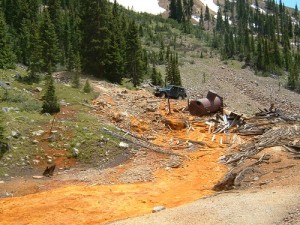 The Good Samaritan Legislation would address the current pollution clean-up laws in the United States. Currently, the Clean Water Act and the Comprehensive Environmental Response, Compensation, and Liability Act, place the clean-up burden on the property owners. But in the case of these abandoned mines, the owners are long-gone. Now the clean-up falls on the shoulders of Good Samaritans like TU and other partners. However, the liabilities in the laws- requiring a project to show significant improvements for a specific period of time and makes the Good Samaritan liable for any failures in improvements- have caused a legal gridlock.
The Good Samaritan Legislation would address the current pollution clean-up laws in the United States. Currently, the Clean Water Act and the Comprehensive Environmental Response, Compensation, and Liability Act, place the clean-up burden on the property owners. But in the case of these abandoned mines, the owners are long-gone. Now the clean-up falls on the shoulders of Good Samaritans like TU and other partners. However, the liabilities in the laws- requiring a project to show significant improvements for a specific period of time and makes the Good Samaritan liable for any failures in improvements- have caused a legal gridlock.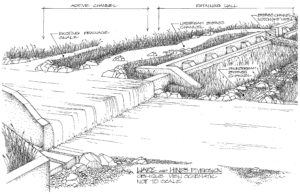 TU partnered with CPW to design and build a fish passage channel around the Ware and Hinds irrigation diversion structure on Elk Creek, a tributary to the Colorado River main-stem with its confluence at New Castle, CO. The Ware and Hinds diversion structure spans the width of the channel and presents a barrier to spawning fish moving out of the Colorado River main-stem
TU partnered with CPW to design and build a fish passage channel around the Ware and Hinds irrigation diversion structure on Elk Creek, a tributary to the Colorado River main-stem with its confluence at New Castle, CO. The Ware and Hinds diversion structure spans the width of the channel and presents a barrier to spawning fish moving out of the Colorado River main-stem The fish passage project could not have moved forward without the work from the Ferdinand-Hayden Chapter by raising $3,000 that allowed for the preliminary engineering to be completed. "This came at a critical time when I needed to finalize our design drawings," said Richard Van Gytenbeek, Colorado River Basin Outreach Coordinator. "Their contribution allowed me to pay the engineer and complete the drawings which kept the project going."
The fish passage project could not have moved forward without the work from the Ferdinand-Hayden Chapter by raising $3,000 that allowed for the preliminary engineering to be completed. "This came at a critical time when I needed to finalize our design drawings," said Richard Van Gytenbeek, Colorado River Basin Outreach Coordinator. "Their contribution allowed me to pay the engineer and complete the drawings which kept the project going."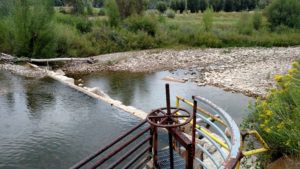 The Elk Creek passage also demonstrates the
The Elk Creek passage also demonstrates the 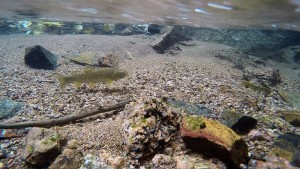

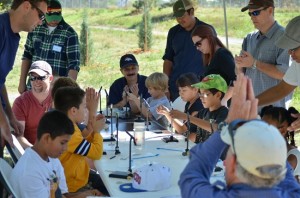
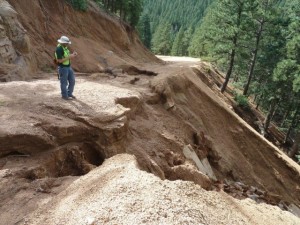 Trout populations can be negatively affected by this excessive sediment, and it can take years for these populations to recover. According to CPW, "The South Platte River in and downstream of the Hayman burn area has only recently begun to return to the quality fishery that it was prior to the fire." The Hayman fire occurred in 2002.
Trout populations can be negatively affected by this excessive sediment, and it can take years for these populations to recover. According to CPW, "The South Platte River in and downstream of the Hayman burn area has only recently begun to return to the quality fishery that it was prior to the fire." The Hayman fire occurred in 2002.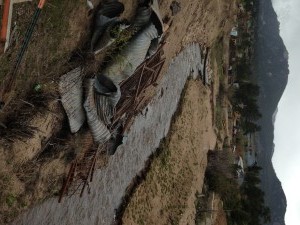
 The mighty river also irrigates more than 1.8 million acres of land- producing about 15 percent of the nation’s crops and about 13 percent of livestock. These totals generate about $1.5 billion a year in agricultural benefits.
The mighty river also irrigates more than 1.8 million acres of land- producing about 15 percent of the nation’s crops and about 13 percent of livestock. These totals generate about $1.5 billion a year in agricultural benefits. Another project in place to keep the Colorado River healthy is the
Another project in place to keep the Colorado River healthy is the  While further on down from the headwaters, Trout Unlimited is teaming up with ranchers and cattlemen to use water
While further on down from the headwaters, Trout Unlimited is teaming up with ranchers and cattlemen to use water 
